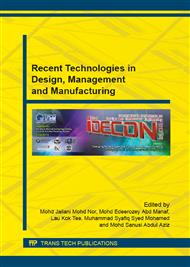[1]
B. Rodgers, Rubber Compounding: Chemistry and Applications, Marcel Dekkal, New York, (2004).
Google Scholar
[2]
H.H. Hassan, E. Ateia, N.A. Darwish, S.F. Halim, A.K. Abd El-Aziz, Effect of filler concentration on the physico-mechanical properties of super abrasion furnace black and silica loaded styrene butadiene rubber, Mater. Design 34 (2012) 533-540.
DOI: 10.1016/j.matdes.2011.05.005
Google Scholar
[3]
A. Mostafa, A. Abouel-Kasem, M.R. Bayoumi, M.G. El-Sebaie, Rubber-filler interactions and its effect in rheological and mechanical properties of filled compounds, J. Test. Eval. 38(3) (2014) 1-13.
DOI: 10.1520/jte101942
Google Scholar
[4]
S. Mihara, R.N. Datta, J.W.M. Noordermeer, Flocculation in silica reinforced rubber compounds, Rubber Chem. Technol. 82 (2009) 524-540.
DOI: 10.5254/1.3548262
Google Scholar
[5]
S.S. Sarkawi, W.K. Dierkes, W.M. Noordermeer, The influence of non-rubber constitiuents on performance of silica reinforced natural rubber compounds, Eur. Polym. J. 49 (2013) 3199-3209.
DOI: 10.1016/j.eurpolymj.2013.06.022
Google Scholar
[6]
G.M. Lee, J.W. Yoo, K.B. Lee, Enhancement of dispersion of silica modified with a silane coupling agent in a rubber composite, J. Chem. Eng. Jpn. 47(2) (2014) 159-164.
DOI: 10.1252/jcej.13we130
Google Scholar
[7]
I. Surya, H. Ismail, A.R. Azura, Alkanolamide as an accelerator, filler-dispersant and a plasticizer in silica-filled natural rubber compounds, Polym. Test. 32 (2013) 1313–1321.
DOI: 10.1016/j.polymertesting.2013.07.015
Google Scholar
[8]
L.E. Yahaya, K.O. Adebowale, A.R.R. Menon, S. Rugmini, B.I. Olu-Owolabi, J. Chameswary, Natural rubber/clay nanocomposites: Effect of filler dosage on the physicomechanical properties of vulcanizates, Afr. J. Pure Appl. Chem. 4(9) (2009) 198-205.
Google Scholar
[9]
N. Rattanasom, S. Prasertsri, Mechanical properties, gas permeability and cut growth behaviour of natural rubber vulcanizates: Influence of clay types and clay/carbon black ratios, Polym. Test. 31 (2012) 645-653.
DOI: 10.1016/j.polymertesting.2012.04.001
Google Scholar
[10]
H. Ismail, M. Mathialagan, Comparative study on the effect of partial replacement of silica or calcium carbonate by bentonite on the properties of EPDM composites, Polym. Test. 31 (2012) 199-208.
DOI: 10.1016/j.polymertesting.2011.09.002
Google Scholar
[11]
N. Hewitt, Compounding Precipitated Silica in Elastomers. Theory and Practice, William Andrew Publishing, New York, (2007).
DOI: 10.1016/b978-0-8155-1528-9.50022-9
Google Scholar
[12]
S.M. Sobhy, D.E. Nashar, N.A. Maziad, Cure characteristics and physicomechanical properties of calcium carbonate reinforcement rubber composites, Egypt. J. Solids. 26(2) (2003) 241-256.
DOI: 10.21608/ejs.2003.150162
Google Scholar
[13]
Y.B. Liu, L. Li, Q. Wang, Reinforcement of natural rubber with carbon black/nanoclay hybrid filler, Plast. Rubber Compos. 39(8) (2010) 370-376.
DOI: 10.1179/174328910x12691245469871
Google Scholar
[14]
Y. Liu, L. Li, Q. Wang, X. Zhang, Fracture properties of natural rubber filled with hybrid carbon black/nanoclay, J. Polym. Res. 18 (2011) 859-866.
DOI: 10.1007/s10965-010-9482-5
Google Scholar
[15]
A.P. Susamma, M. Kurien, A.P. Kuriakose, New binary accelerator systems for sulphur vulcanization of styrene butadiene rubber, Plast. Rubber Compos. 33 (2004) 63-70.
DOI: 10.1179/146580103225004405
Google Scholar
[16]
Q. Ahsan, N. Mohamad, T.C. Soh, "Effects of Calcined Clay and Precipitated Silica on Cure and Mechanical Properties through Prolong Multiple Stages Mixing on Natural Rubber Compound˝, 2nd International Conference on Design and Concurrent Engineering, Oct (2012).
Google Scholar
[17]
Q. Ahsan, N. Mohamad, T.C. Soh, Effects of Various Accelerators on Cure Characteristics and Mechanical Properties on Natural Rubber Compound, International Conference on Design and Concurrent Engineering, Oct (2012).
Google Scholar
[18]
N. Mohamad, A. Muchtar, M.J. Ghazali, D. Mohamad, C.H. Azhari, Epoxidized natural rubber-alumina nanoparticle composite: Optimization of mixer parameters via Response Surface Methodology, J. Appl. Polym. Sci. 115 (2009) 183-189.
DOI: 10.1002/app.31056
Google Scholar
[19]
J.G. Drobny, Radiation Technology for Polymer, CRC Press, New York, (2010).
Google Scholar
[20]
T. Fukuda, S. Fujii, Y. Nakamura, M. Sasaki, Mechanical properties of silica particle-filled styrene-butadiene rubber composites containing polysulphide-type silane coupling agents: Influence of loading method of silane, J. Appl. Polym. 130(1) (2013).
DOI: 10.1002/app.39175
Google Scholar


